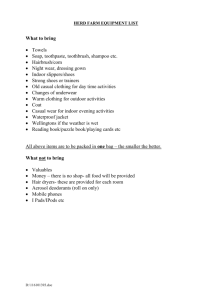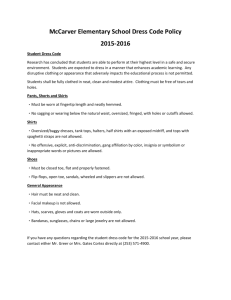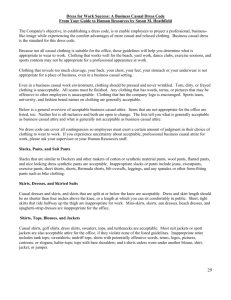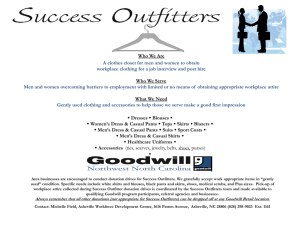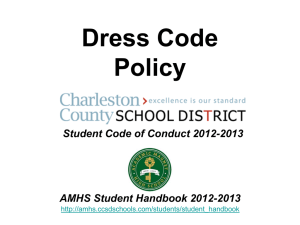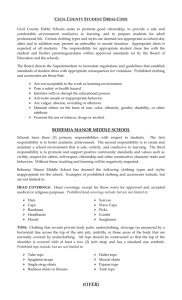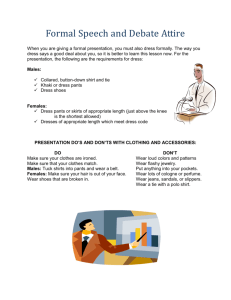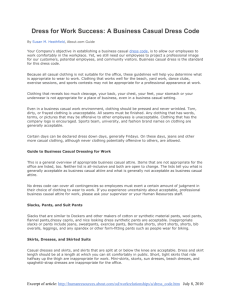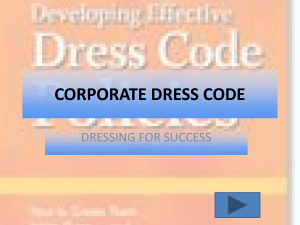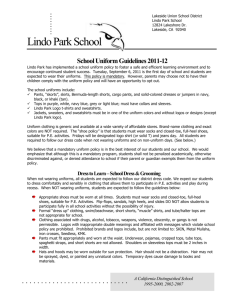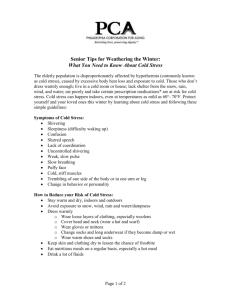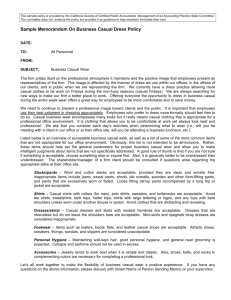Dress Code Policy NEHD 2015
advertisement
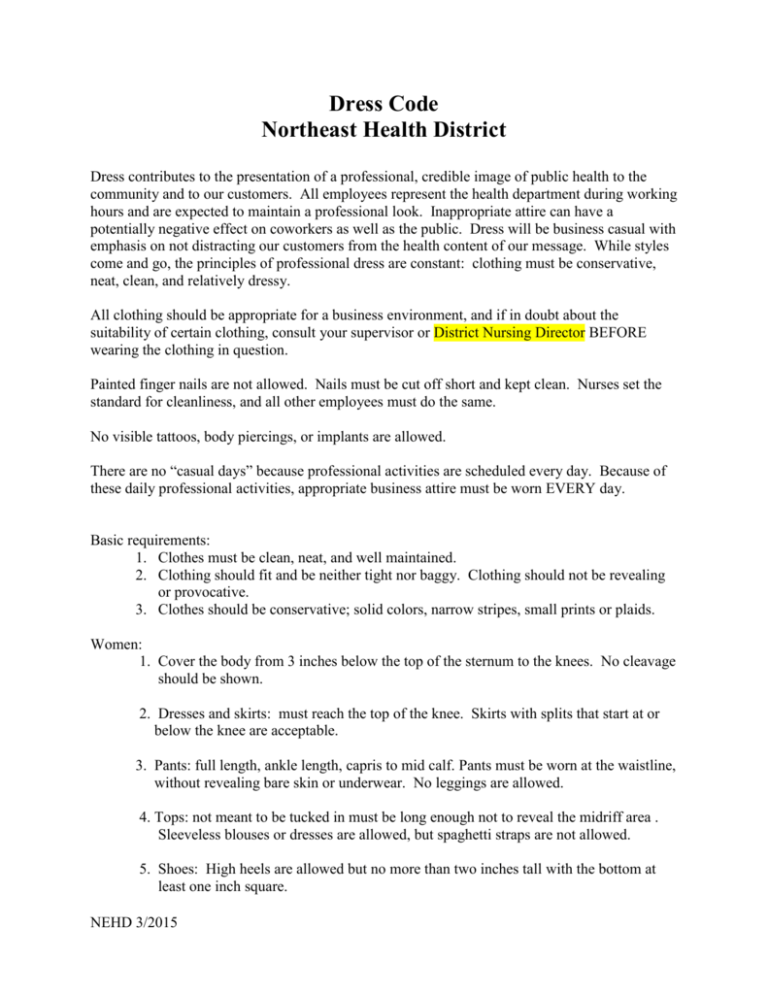
Dress Code Northeast Health District Dress contributes to the presentation of a professional, credible image of public health to the community and to our customers. All employees represent the health department during working hours and are expected to maintain a professional look. Inappropriate attire can have a potentially negative effect on coworkers as well as the public. Dress will be business casual with emphasis on not distracting our customers from the health content of our message. While styles come and go, the principles of professional dress are constant: clothing must be conservative, neat, clean, and relatively dressy. All clothing should be appropriate for a business environment, and if in doubt about the suitability of certain clothing, consult your supervisor or District Nursing Director BEFORE wearing the clothing in question. Painted finger nails are not allowed. Nails must be cut off short and kept clean. Nurses set the standard for cleanliness, and all other employees must do the same. No visible tattoos, body piercings, or implants are allowed. There are no “casual days” because professional activities are scheduled every day. Because of these daily professional activities, appropriate business attire must be worn EVERY day. Basic requirements: 1. Clothes must be clean, neat, and well maintained. 2. Clothing should fit and be neither tight nor baggy. Clothing should not be revealing or provocative. 3. Clothes should be conservative; solid colors, narrow stripes, small prints or plaids. Women: 1. Cover the body from 3 inches below the top of the sternum to the knees. No cleavage should be shown. 2. Dresses and skirts: must reach the top of the knee. Skirts with splits that start at or below the knee are acceptable. 3. Pants: full length, ankle length, capris to mid calf. Pants must be worn at the waistline, without revealing bare skin or underwear. No leggings are allowed. 4. Tops: not meant to be tucked in must be long enough not to reveal the midriff area . Sleeveless blouses or dresses are allowed, but spaghetti straps are not allowed. 5. Shoes: High heels are allowed but no more than two inches tall with the bottom at least one inch square. NEHD 3/2015 Women may wear sandals or open toe shoes, but the feet must be well groomed and subdued nail polish allowed. Flip flops are not allowed. If nurses are seeing patients, they should not wear sandals or open toe shoes. They can wear sandals or open toe shoes to meetings and trainings. 6. Hair must be neat and well-groomed 7. Only conservative jewelry may be worn ( watch, wedding rings, simple earrings, simple necklace) Conventional women’s earrings that are small and do not dangle are allowed. 8. Fingernails must be kept short, clean, and groomed. No nail polish on fingernails due to infection control issues. Men: The following is considered appropriate for Business Casual attire: 1. Shirts: button down shirts or knit polo shirts with collars, dress shirts, sweaters, and turtlenecks are acceptable. 2. Slacks: No denim. 3. Shoes: Must complement the outfit. Loafers, dress boots (when appropriate for cooler weather), clean, conservative solid color tennis/aerobic walking shoes may be work. Socks (either the color of the shoe or the apparel) should be appropriate to the type of shoe or apparel. Recommended and/or allowed for nurses, health educators, and others providing direct patient care: Nurses may wear scrubs or business casual attire with a lab coat. Health educators/health counselors/peer counselors/dietitians/nutritionists/social workers may wear khakis and polo shirts, business casual with lab coat, or scrubs. Not allowed (ALL EMPLOYEES) 1. Jeans, bib overalls, skorts, and shorts (of any length) 2. Leggings, form fitting stretch knit pants, biking clothing, or other tight pants/slacks. 3. Tight fitting tops, cleavage exposure, off the shoulder tops, tube tops, halter tops, tank tops, muscle shirts, spaghetti strap dresses, sundresses, strapless dresses, low cut tops, bare midriff tops. (Modest tank tops are permitted if worn with a sweater, suit ensemble, or covered by a business jacket. 4. Mini or micro skirts 5. Jelly shoes, flip-flops, bedroom shoes, combat boots or other chunky style boots. NEHD 3/2015 6. Sweatshirts, sweat suits, sweat pants, warm-up suits, other athletic apparel, t-shirts with logos (other than those provided/approved by employer), slogans, or large letter advertising. 7. Casual t-shirts or other clothing with writing, cartoons, pictures, logos, or slogans. 8. Any clothing item or style associated with gangs. 9. Torn, patched or faded clothing 10. Visible body piercing, surface piercing, large gauge ear piercing, extraocular implants, subdermal implants, or similar “body art.” (Pierced ears allowed, but only one set of small conservative earrings may be worn. 11. Visible tattoos, scarification, branding, scalpeling, body or face painting, or similar “body art” *Environmentalists who usually wear khakis and a shirt with public health logo, may wear jeans for field work when necessary. Miscellaneous 1. Many employees and patients are sensitive to environmental irritants such as fragrance. In consideration of others, employees may absolutely not use perfume or other scented personal products at work. 2. Chewing gum is not permitted. 3. Makeup and hairstyles should be subdued. Excessive makeup and trend-setting hairstyles attract too much attention and tend to be distracting for patients and others. If clothing fails to meet these standards, as determined by the employee’s supervisor and District Nursing Director, the employee will be asked not to wear the inappropriate item to work again, or the employee may be sent home to change clothes and will receive a verbal warning for the first offense. All other policies about personal time use will apply if the employee is sent home to change clothes. Progressive disciplinary action will be applied if dress code violations continue. If you are unsure about a dress/appearance related issue, please check with your supervisor. Employees who are non-compliant with NEHD dress code will be subject to disciplinary action. Those employees, who need to wear jeans (due to the nature of their jobs) may do so with supervisor’s approval and only on the specific days needed. Decisions regarding the appropriateness of dress will be made by supervisor and the District Nursing Director office. Please sign below indicating that you have read and understand this dress code. ___________________________________________________________________ Signature NEHD 3/2015 Date
